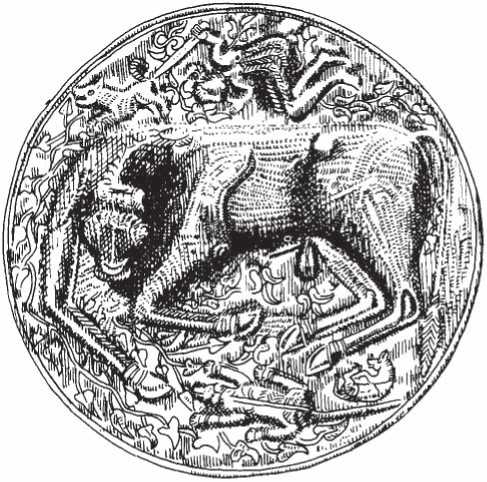Ritual behaviour involving the deliberate killing of animals was endemic in Celtic society: the evidence for this activity is manifest in sanctuaries, graves and habitation sites, the last context indicating that the ritual was not an elite one and that it is impossible to separate symbolic from economic behaviour. Rituals involving animals did not, of course, first take place during the Celtic Iron Age. In Britain, for instance, there is abundant prehistoric evidence: the deposition of animals in the ditches of Neolithic causewayed camps, and the 'head and hooves' burials of the Neolithic and Bronze Age are examples.1 Sometimes the animals involved in Celtic ritual were eaten or partially eaten; sometimes whole or parts of bodies of beasts were offered to the gods. It is possible to observe a complex but systematic behaviour-pattern in animal ritual. The results of such activity are interpreted as ritual since they are repetitive, have no explicable function in terms of 'rational' behaviour and sometimes involve a considerable economic loss to the community.2 In any ritual, there is a strong element of formalized, repeated action, prescribed and circumscribed by certain rules and taboos, which are adhered to and handed down. It is crucial to recognize that for the Celts ritual behaviour was not marginal but central to everyday life.3 This is why such behaviour manifests itself not just in sacred places nor within the context of funerary activity, but in the places where people lived their daily lives. Thus in southern Britain and elsewhere (see pp. 100-5) grain-storage pits in hillforts and isolated settlements were the centres for complicated ritual activities involving animals.4
There are many possible explanations for animal ritual. Animals were considered important in religion because they played a central and crucial part in life. Cattle, for instance, were a symbol of wealth. They were used as draught beasts; their flesh was eaten; their hides used to make leather; and their milk drunk or made into cheese. Animals were important as food, in hunting and in warfare and were thus of equal importance in death and religion.5 In sanctuaries, ritual feasting and offerings of food to the dead involved the butchery of animals. In the disused storage pits of southern Britain, the burial of animals may have been magico-religious

Figure 5.1 Baseplate of the Gundestrup Cauldron, depicting the hunt or sacrifice of a great bull. Diameter of baseplate: 25.6cm. Paul Jenkins.
Acts which represented the deliberate loss to their rural communities of potential wool, milk, manure, traction, meat and offspring.6 Here, then, fertility rites may have been carried out to ensure that the gods were involved in acts of reciprocity and that the divine powers would continue to provide for humankind.
It is important to remember that much of the ritual which must have taken place does not survive in the archaeological record. Holocausts, where the complete body of an animal was burnt, might leave no trace. In addition, it is sometimes difficult to detect a difference between evidence for animal ritual and ordinary food refuse. Among the Iban of Borneo,7 food ritual involving animals takes place on house verandahs and would be archaeologically indistinguishable from normal butchery and food consumption. Indeed, animals involved in ritual in many societies would be eaten either as part of or after their ritual usage.




 World History
World History









